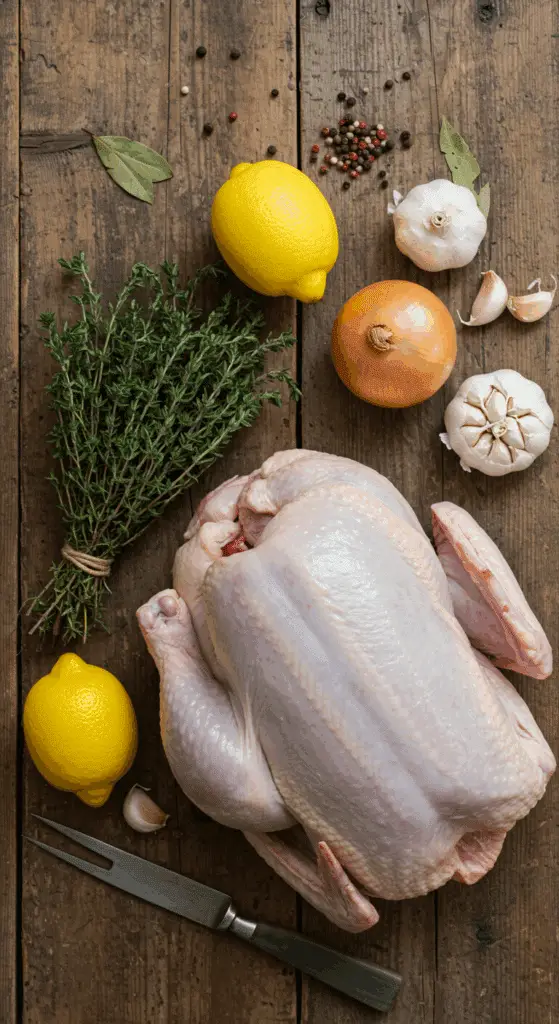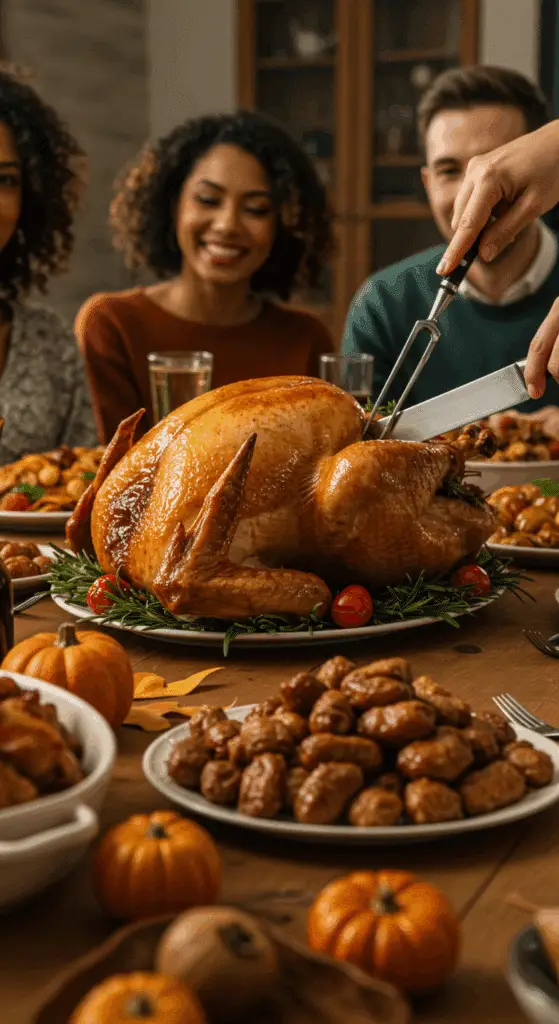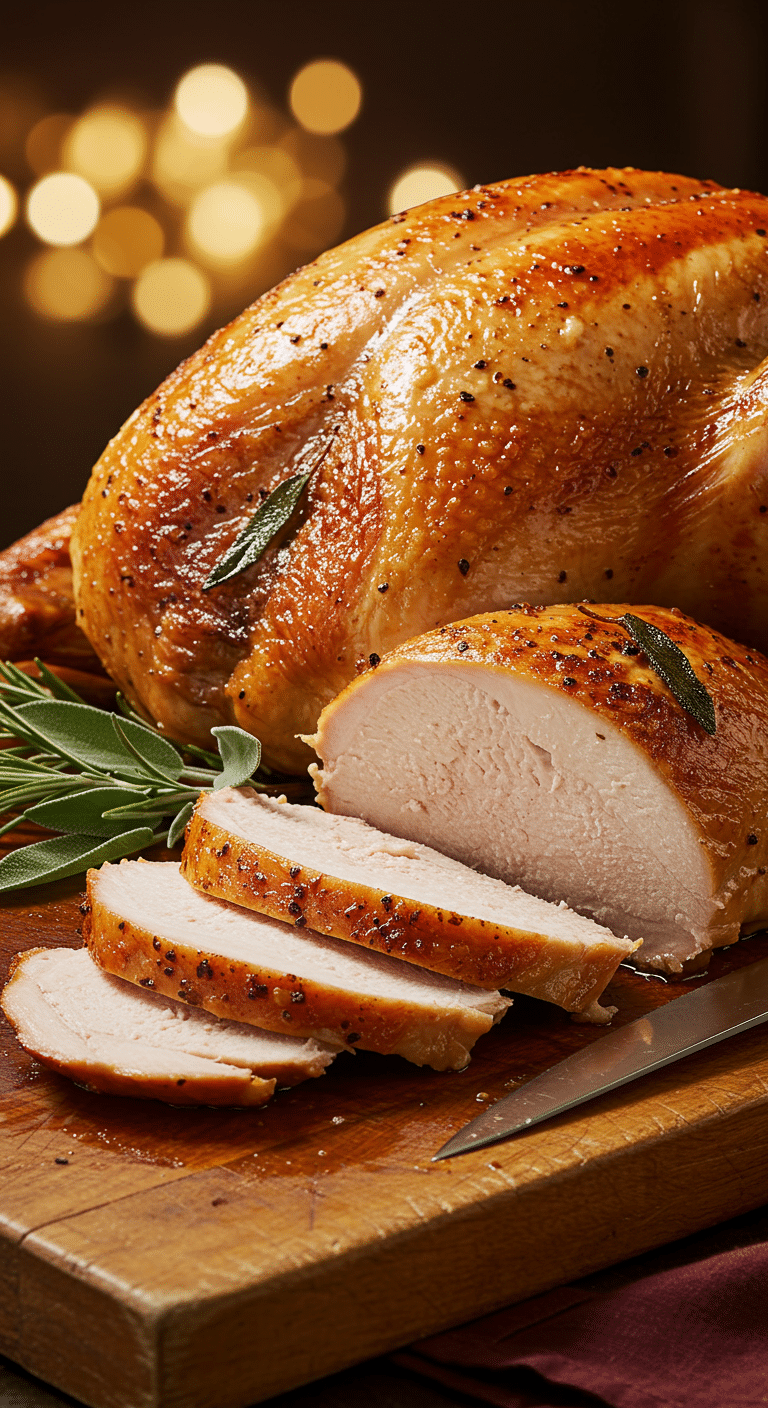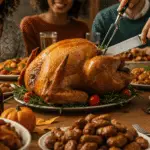Does the thought of roasting a whole turkey for the holidays fill you with a little bit of stress and intimidation? It doesn’t have to! This simple, classic, and completely foolproof recipe for the World’s Simplest Thanksgiving Turkey is your ultimate roadmap to a stunning, juicy, golden-brown, and absolutely perfect bird, every single time.
This isn’t a recipe with a hundred fussy steps or complicated, gourmet ingredients. This is a guide to mastering the timeless, traditional method of roasting a turkey, focusing on the few simple but crucial techniques that make all the difference. We’ll cover everything from prepping the bird to the two-stage roasting process for moist meat and crispy skin, and the all-important final rest. Get ready to create the perfect holiday centerpiece with total confidence.
Table of Contents
Table of Contents
Recipe Overview: The Ultimate Foolproof Holiday Turkey
What makes this roasted turkey recipe so perfect for beginners and seasoned cooks alike is its focus on simple, classic flavors and a straightforward, reliable technique. The bird is simply seasoned, filled with classic aromatics like onion, lemon, and herbs, and basted with butter to create a rich flavor and beautiful color. The two-stage roasting method—a long, slow, covered roast followed by a final, high-heat blast—is a brilliant and foolproof way to ensure the meat is cooked through and succulent while the skin becomes shatteringly crisp and golden brown.
| Metric | Time / Level |
| Total Time | 4 hours (includes resting time) |
| Active Prep Time | 20 minutes |
| Difficulty Level | Easy |
| Servings | 8-10 |
The Essential Ingredients for a Perfect Turkey
This recipe uses a handful of simple, classic ingredients to let the turkey shine.
- A Whole Turkey: The star of the show. This recipe is designed for one 10- to 12-pound fresh or fully thawed turkey. Planning ahead to ensure your turkey is fully thawed is the most important step for a successful holiday meal.
- The Aromatics: We stuff the cavity of the turkey with a simple, classic, and incredibly fragrant blend that will perfume the meat from the inside out as it roasts. You’ll need:
- Onion, Carrots, and Apples: A sweet and savory mix.
- Fresh Herbs: A large bunch of classic poultry herbs like thyme, parsley, rosemary, and sage.
- Lemon & Garlic: A halved lemon adds a wonderful, bright acidity, and a halved head of garlic adds a mellow, savory depth.
- Unsalted Butter: A generous brushing of melted, unsalted butter all over the skin is the secret to a rich, flavorful, and beautifully golden-brown and crispy result.
- Kosher Salt & Freshly Ground Black Pepper: The two most important seasonings. We use them generously both inside the cavity and all over the outside of the turkey to ensure every single bite is perfectly seasoned.
The Most Important Prep: How to Safely Thaw a Turkey
If you have a frozen turkey, you must thaw it completely and safely before you begin.
- Refrigerator Thawing (Safest Method): This is the best and safest way. Place your wrapped, frozen turkey in a pan on the bottom shelf of your refrigerator. As a general rule, you should allow at least 24 hours of thawing time for every 4 to 5 pounds of turkey.
- 12-pound turkey = at least 3 full days in the refrigerator.
- Cold Water Thawing (Faster Method): If you are short on time, you can thaw the turkey in cold water. Submerge the wrapped turkey in a clean sink or a large cooler filled with cold tap water. You must change the water every 30 minutes to ensure it stays cold and safe. This method takes about 30 minutes per pound, so a 12-pound turkey will take about 6 hours.

Step-by-Step to the Juiciest Roasted Turkey
Roasting a turkey is a rewarding project. Follow these detailed steps for a perfect, no-fail result.
Step 1: Prepare the Oven and the Turkey
First, adjust an oven rack to the lowest position and preheat your oven to 325°F (165°C).
Prepare your turkey. Remove the giblets (heart, gizzard, liver) and the neck from the turkey’s cavities. Discard the liver, as it can be bitter, but save the neck and other giblets for making a delicious, rich gravy.
Rinse the turkey inside and out with cold water. The most important prep step: pat the turkey completely dry, both inside and out, with paper towels. A very dry surface is the key to a super crispy, golden-brown skin.
Place the dried turkey, breast-side up, in a large roasting pan, preferably one with a roasting rack.
Step 2: Season and Fill with Aromatics
Liberally season the inside of the turkey cavity with kosher salt and freshly ground black pepper.
Stuff the cavity with the fresh thyme, the halved lemon, the quartered onion, the chopped carrots, the apple, and the halved head of garlic.
Step 3: Butter and Truss the Bird
Brush the entire outside of the turkey with the 4 tablespoons of melted butter. Then, sprinkle the skin generously with more salt and pepper.
To ensure the turkey cooks evenly and has a beautiful, compact shape, you should truss the legs. Simply cross the legs and tie them together tightly with a piece of kitchen string. Finally, tuck the wing tips under the body of the turkey.
Step 4: The Two-Stage Roast to Perfection
First Roast (Low and Slow): Loosely tent the turkey with a piece of aluminum foil. This will protect the delicate breast meat and prevent the skin from browning too quickly during the long initial roast. Place the turkey in the preheated 325°F oven and roast for 2 hours.
Second Roast (High Heat for Crispy Skin): After 2 hours, carefully remove the foil from the turkey. Baste the turkey with more melted butter or the pan juices that have accumulated in the bottom of the roasting pan.
Increase the oven temperature to a hot 425°F (220°C).
Return the uncovered turkey to the oven and continue to roast until the skin is a beautiful, deep golden brown and crispy, and the turkey is cooked through. This will take another hour or so.
The turkey is perfectly and safely cooked when an instant-read thermometer inserted into the thickest part of the thigh (making sure not to touch the bone) registers 165°F (74°C). The old-fashioned method of checking for “clear juices” is not a reliable or safe indicator of doneness.
Step 5: The All-Important Rest
Carefully transfer the roasted turkey from the pan to a large cutting board. Let the turkey rest, uncovered, for at least 20 to 30 minutes before you even think about carving it.
This is the single most important step for a juicy turkey! This allows the juices, which have been pushed to the center of the meat during cooking, to relax and redistribute throughout the entire bird, ensuring every slice is moist and succulent.
While the turkey is resting, use the incredibly flavorful pan drippings to make a delicious gravy.

The World’s Simplest & Juiciest Thanksgiving Turkey
A straightforward and simple recipe for a classic Thanksgiving turkey. The method involves seasoning a whole turkey inside and out, filling the cavity with aromatics like onion, carrots, apples, and herbs, and then brushing the skin with melted butter. The turkey is roasted using a two-temperature method: first at a low temperature while tented with foil to cook it gently, and then at a high temperature, uncovered, to achieve a perfectly golden-brown and crisp skin.
- Prep Time: 20 minutes
- Cook Time: 3 hours
- Total Time: 3 hours 40 minutes (includes resting time)
- Yield: 8-12 servings
- Category: Main Course
- Method: Roasting
- Cuisine: American
- Diet: Gluten Free
Ingredients
- 1 (10- to 12-pound) turkey
- Neck and giblets (liver discarded)
- Kosher salt and freshly ground black pepper
- 1 onion, chopped
- 1 carrot, chopped
- 1 apple, chopped
- 1 bunch fresh herbs (e.g., thyme, sage, rosemary)
- 1/2 cup (1 stick) melted butter
Instructions
- Preheat the oven to 325°F.
- Remove the neck and giblets from the turkey cavity; discard the liver and save the rest for making gravy if desired.
- Thoroughly dry the turkey inside and out with paper towels.
- Season the turkey generously inside and out with salt and pepper.
- Fill the main cavity of the turkey with the chopped onions, carrots, apples, and fresh herbs.
- Place the turkey breast-side up in a roasting pan. Brush the entire outside of the turkey with melted butter.
- Tent the turkey loosely with aluminum foil.
- Roast for 2 hours (for a 10- to 12-pound turkey, adding 15 minutes per pound for larger birds).
- Remove the foil, baste the turkey with more melted butter, and increase the oven temperature to 425°F.
- Continue to roast, uncovered, for another hour or until an instant-read thermometer inserted into the thickest part of the thigh registers 165°F.
- Transfer the turkey to a cutting board, cover loosely with foil, and let it rest for at least 20-30 minutes before carving.
Notes
- This recipe provides inferred quantities for aromatics and butter, as they were not specified in the original article.
- Patting the turkey skin completely dry is a crucial step for achieving a crispy skin.
- The two-temperature roasting method ensures the turkey cooks evenly without drying out, while also browning the skin beautifully at the end.
- Resting the turkey after roasting is essential for a juicy, tender result.
Storage and Make-Ahead Tips
A large roasted turkey is perfect for delicious leftovers.
- Make-Ahead: While a turkey is best roasted on the day you plan to serve it, you can do some prep work ahead of time. You can prepare your aromatic vegetables and have your seasonings ready to go.
- Storage: Store any leftover carved turkey meat in an airtight container in the refrigerator for up to 4 days. The leftover carcass and bones are a treasure—use them to make a rich and delicious turkey stock for soup.
For more recipe follow my Pinterest account
Creative Recipe Variations
This simple and classic recipe is a perfect canvas for your own delicious and creative twists.
- Make a Savory Herb Butter: For an even more flavorful and self-basted turkey, you can make a compound butter. In a bowl, mix 1 stick (8 tablespoons) of softened butter with finely chopped fresh herbs (like sage, thyme, and rosemary), a few cloves of minced garlic, and the zest of one lemon. Carefully loosen the skin of the turkey from the meat and rub half of this butter mixture under the skin, directly on the meat. Rub the remaining half all over the outside of the skin.
- Try a Dry Brine: For an even juicier bird with guaranteed super crispy skin, you can try a dry brine. A day or two before you plan to roast, rub the entire turkey, inside and out, with a mixture of kosher salt (about 1 tablespoon for every 4 pounds), a little bit of sugar, and your favorite dried herbs. Let the turkey rest, uncovered, on a rack in the refrigerator.
- Use a Different Citrus Aromatic: Instead of a lemon, you can stuff the cavity with a halved orange or even a grapefruit along with the onion and garlic for a different, bright, citrusy aroma that is wonderful with poultry.
Enjoy Your Holiday Masterpiece!
You’ve just created a stunning, impressive, and perfectly cooked turkey that is guaranteed to be the star of your holiday table. This Perfect Roast Turkey is a testament to the power of a simple, classic technique to produce a truly spectacular result. It’s a foolproof recipe that will give you the confidence to roast a perfect bird every single time.
We hope you and your loved ones enjoy every last, juicy, and delicious bite!
If you enjoyed making this recipe, please leave a comment below or share it with a friend who is looking for a no-fail turkey recipe!
Frequently Asked Questions (FAQs)
Q1: How big of a turkey do I need to buy for my gathering?
A good rule of thumb is to plan for about 1 to 1 1/2 pounds of turkey per person. This will ensure you have enough for the main meal and some delicious leftovers. So, for 8-10 people, a 12-pound turkey is a perfect size.
Q2: How do I know for sure when my turkey is done?
Do I really need a meat thermometer? Yes, you absolutely need a meat thermometer. It is the only foolproof and safe way to know for sure when your turkey is perfectly cooked. The old-fashioned methods, like checking for clear juices or wiggling the leg, are not reliable and can lead to an undercooked or overcooked bird. An instant-read thermometer is an inexpensive and essential kitchen tool.
Q3: Where is the best place to insert a meat thermometer in a whole turkey?
The most reliable spot to check for doneness is the thickest part of the thigh. Carefully insert your instant-read thermometer into the meatiest part of the inner thigh, making sure that the probe is not touching the bone (as the bone will be hotter than the meat). The temperature should read at least 165°F (74°C).
Q4: Why do you tent the turkey with foil
Tenting the turkey with foil for the first part of the roasting is a great trick to ensure a juicy bird. The foil protects the delicate breast meat from the direct heat of the oven, allowing it to cook gently and stay moist while the slower-cooking thighs have time to come up to temperature. You then remove the foil at the end to allow the skin to get beautifully browned and crispy.
Q5: What are the giblets, and what should I do with them?
The giblets are the edible organs of the turkey, usually consisting of the heart, gizzard, and liver, which you’ll find in a small paper or plastic bag inside the turkey’s cavity, along with the neck. The neck, heart, and gizzard are a treasure trove of flavor and are fantastic for making a rich, homemade gravy or stock while your turkey roasts. It is usually recommended to discard the liver, as it can sometimes impart a bitter or metallic taste to your stock.


